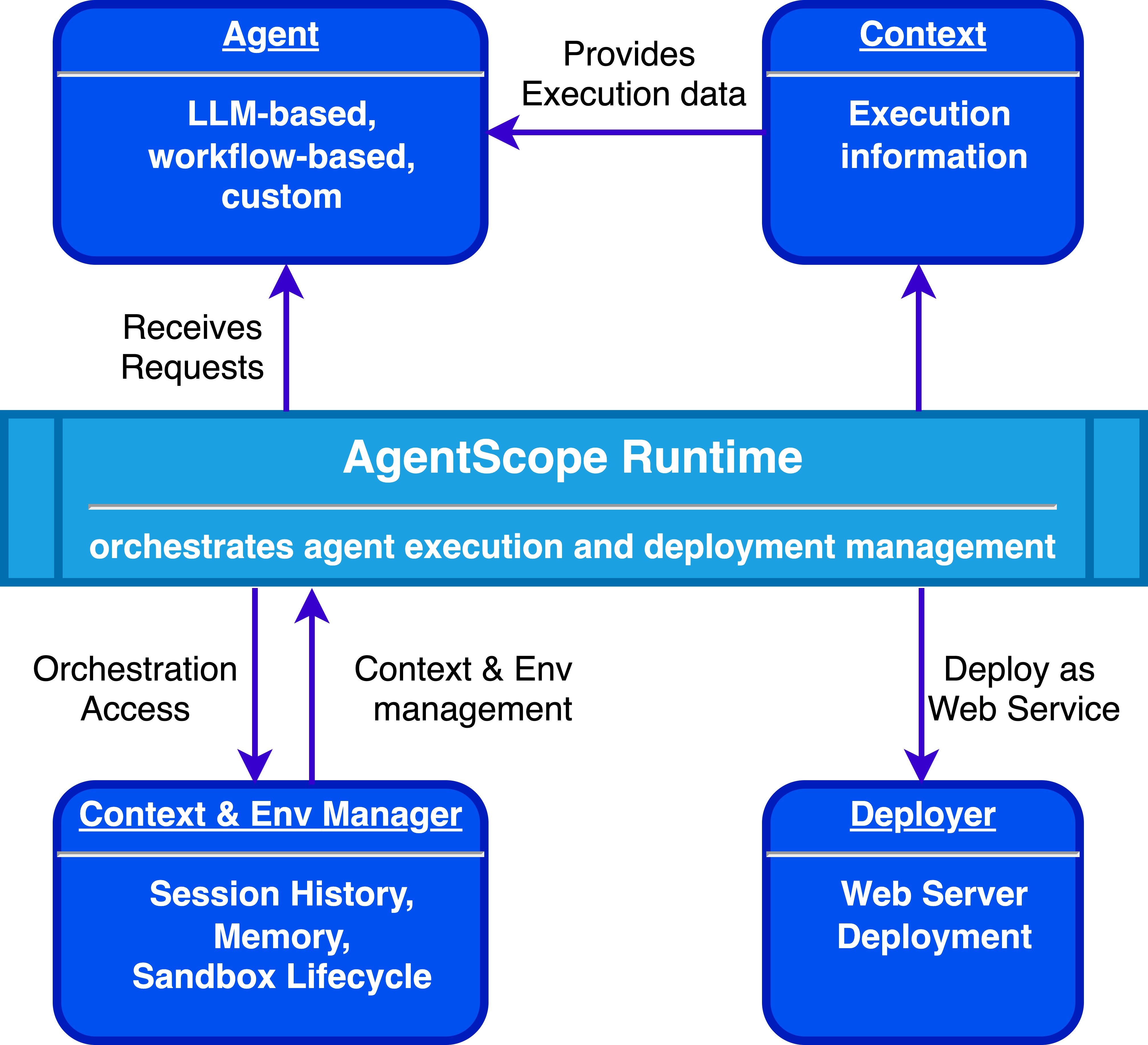2. Concepts¶
This chapter introduces the core concepts of AgentScope Runtime, which provides two main usage patterns:
Agent Deployment: Use the Engine Module for full-featured agent deployment with runtime orchestration, context management, and production-ready services
Sandboxed Tool Usage: Use the Sandbox Module independently for secure tool execution and integration in your own applications
Engine Module Concepts¶
Architecture¶
The engine module in AgentScope Runtime uses a modular architecture with several key components:

Agent: The core AI component that processes requests and generates responses (can be LLM-based, workflow-based, or custom implementations, such as Agentscope, Agno, LangGraph)
AgentApp: Inherits from the FastAPI App and serves as the application entry point. It is responsible for providing external API interfaces, registering routes, loading configurations, and delegating incoming requests to the Runner for execution.
Runner: Orchestrates the agent execution and manages deployment at runtime
Context: Contains all the information needed for agent execution
Context & Env Manager: Provide additional functional services management, such as session history management, long-term memory management, and sandbox management.
Deployer: Deploy the Runner as a service
Key Components¶
1. Agent¶
The Agent is the core component that processes requests and generates responses. It’s an abstract base class that defines the interface for all agent types. We’ll use AgentScopeAgent as our primary example, but the same deployment patterns apply to all agent types.
2. AgentApp¶
AgentApp is the entry point of applications in the AgentScope Runtime. It inherits from BaseApp (a base class that extends FastAPI and optionally integrates Celery) and is used to deploy an Agent as an API application that provides services externally.
Its responsibilities include:
Initializing and binding the Agent and Runner, delegating requests to the runtime for processing
Providing standardized HTTP API endpoints (including health checks)
Supporting Server-Sent Events (SSE) as well as standard JSON responses
Allowing registration of middlewares, task queues (Celery), and custom routes
Managing the application lifecycle (supports
before_start/after_finishhooks)
3. Runner¶
The Runner class provides a flexible and scalable runtime that orchestrates agent execution and offers deployment capabilities. It manages:
Agent lifecycle
Session management
Streaming responses
Service deployment
4. Context¶
The Context object contains all the information needed for agent execution:
Agent instance
Session information
User request
Service instances
5. Context & Env Manager¶
Includes ContextManager and EnvironmentManager:
ContextManager: Provides session history management and long-term memory management.EnvironmentManager: Provides sandbox lifecycle management.
6. Deployer¶
The Deployer system provides production-ready deployment capabilities:
Deploy Runner as a service.
Health checks, monitoring, and lifecycle management
Real-time response streaming with SSE
Error handling, logging, and graceful shutdown
Sandbox Module Concepts¶
Architecture¶
The Sandbox Module provides a secure and isolated execution environment for various operations including MCP tool execution, browser automation, and file system operations. The architecture is built around three main components:
Sandbox: Containerized execution environments that provide isolation and security
Tools: Function-like interfaces that execute within sandboxes
Sandbox Types¶
The system supports multiple sandbox types, each optimized for specific use cases:
1. BaseSandbox¶
Purpose: Basic Python code execution and shell commands
Use Case: Essential for fundamental tool execution and scripting
Capabilities: IPython environment, shell command execution
2. GuiSandbox¶
Purpose: GUI interaction and automation with secure access control
Use Case: User interface testing, desktop automation, and interactive workflows
Capabilities: Simulated user input (clicks, typing), window management, screen capture, etc.
3. FilesystemSandbox¶
Purpose: File system operations with secure access control
Use Case: File management, text processing, and data manipulation
Capabilities: File read/write, directory operations, file search and metadata, etc.
4. BrowserSandbox¶
Purpose: Web browser automation and control
Use Case: Web scraping, UI testing, and browser-based interactions
Capabilities: Page navigation, element interaction, screenshot capture, etc.
5. TrainingSandbox¶
Purpose: Agent training and evaluation environments
Use Case: Benchmarking and performance evaluation
Capabilities: Environment profiling, training data management
Tool Module¶
Function-Like Interface¶
Tools are designed with an intuitive function-like interface that abstracts sandbox complexity while providing maximum flexibility:
Direct Execution: Tools can be called directly, automatically creating temporary sandboxes
Sandbox Binding: Tools can be bound to specific sandbox instances for persistent execution contexts
Schema Definition: Each tool has a defined schema specifying input parameters and expected behavior
Tool Execution Priority¶
The tool module implements a three-level sandbox specification priority:
Temporary Sandbox (Highest): Specified during function call
Instance-Bound Sandbox (Second): Specified through binding method
Dry-run mode (lowest priority, no sandbox specified): Automatically creates temporary sandbox when none specified, which will be released after tool execution
Immutable Binding¶
When a tool is bound to a specific sandbox, a new tool instance is created rather than modifying the original. This immutable binding pattern ensures thread safety and allows multiple sandbox-bound versions of the same tool to coexist without interference.